Initiating and Planning Projects: Lessons Learned Report (PPMP20008)
VerifiedAdded on 2022/10/01
|12
|2543
|19
Report
AI Summary
This report provides a comprehensive analysis of lessons learned in the context of project initiation and planning, specifically focusing on the PPMP20008 course. The report emphasizes the importance of continuous learning throughout the project lifecycle, highlighting the roles of stakeholders and the significance of documenting lessons learned. It details a framework for identifying, gathering, and documenting lessons, including the use of previous project data and mitigation strategies. The report then presents three key lessons learned, focusing on design, risk planning, implementation techniques, and verification/validation, each with corresponding improvement strategies. Each lesson includes a situation, the student's feelings, and what was learned. The improvement strategies outline how to measure success, why the strategy is achievable, and its relevance to the lesson, including the timeline for implementation. The report underscores the importance of risk planning, stakeholder agreement, and iterative improvement in project management, aiming to enhance project success and efficiency. The student used a framework to reflect on their experiences and offer insights to improve their understanding of project management.
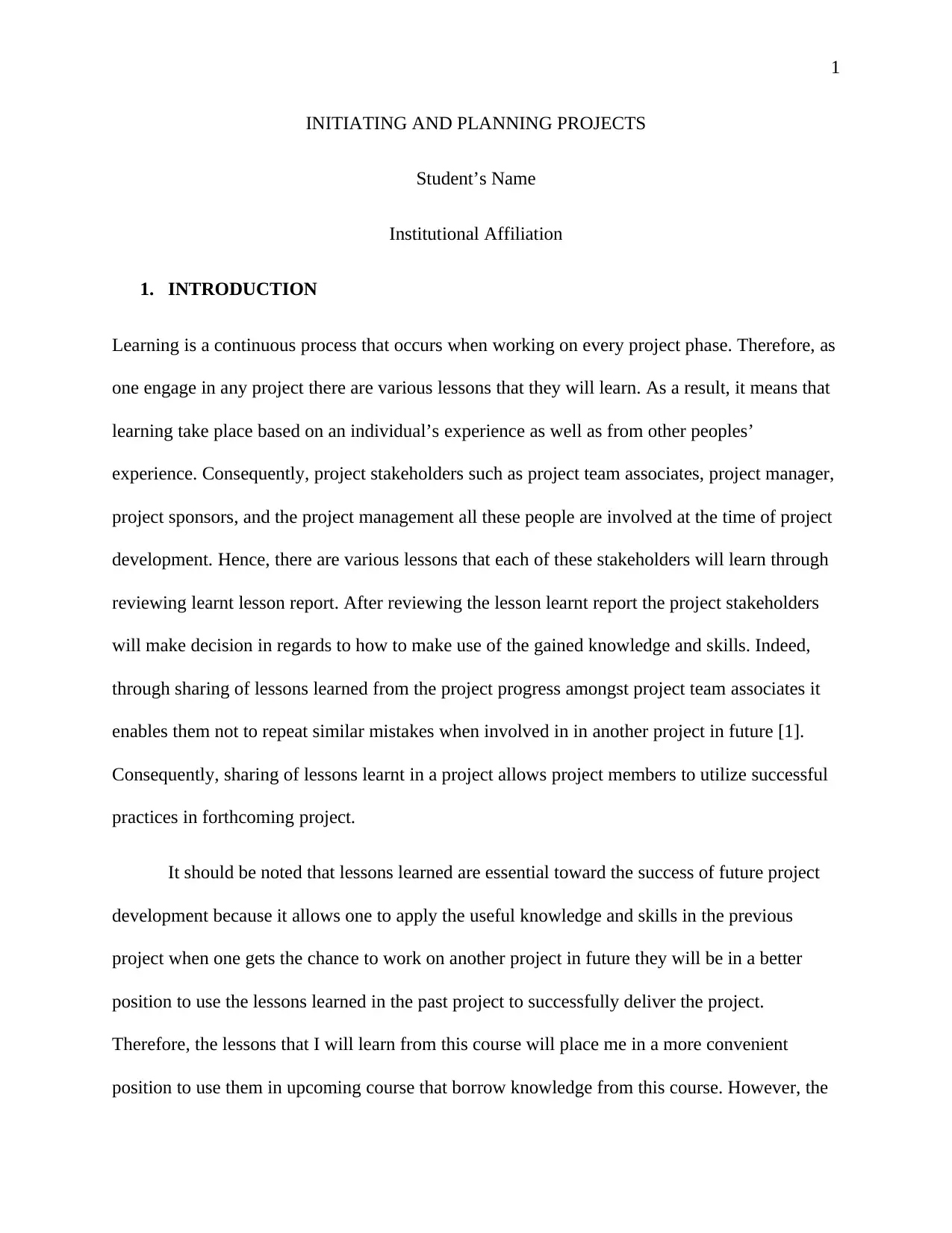
1
INITIATING AND PLANNING PROJECTS
Student’s Name
Institutional Affiliation
1. INTRODUCTION
Learning is a continuous process that occurs when working on every project phase. Therefore, as
one engage in any project there are various lessons that they will learn. As a result, it means that
learning take place based on an individual’s experience as well as from other peoples’
experience. Consequently, project stakeholders such as project team associates, project manager,
project sponsors, and the project management all these people are involved at the time of project
development. Hence, there are various lessons that each of these stakeholders will learn through
reviewing learnt lesson report. After reviewing the lesson learnt report the project stakeholders
will make decision in regards to how to make use of the gained knowledge and skills. Indeed,
through sharing of lessons learned from the project progress amongst project team associates it
enables them not to repeat similar mistakes when involved in in another project in future [1].
Consequently, sharing of lessons learnt in a project allows project members to utilize successful
practices in forthcoming project.
It should be noted that lessons learned are essential toward the success of future project
development because it allows one to apply the useful knowledge and skills in the previous
project when one gets the chance to work on another project in future they will be in a better
position to use the lessons learned in the past project to successfully deliver the project.
Therefore, the lessons that I will learn from this course will place me in a more convenient
position to use them in upcoming course that borrow knowledge from this course. However, the
INITIATING AND PLANNING PROJECTS
Student’s Name
Institutional Affiliation
1. INTRODUCTION
Learning is a continuous process that occurs when working on every project phase. Therefore, as
one engage in any project there are various lessons that they will learn. As a result, it means that
learning take place based on an individual’s experience as well as from other peoples’
experience. Consequently, project stakeholders such as project team associates, project manager,
project sponsors, and the project management all these people are involved at the time of project
development. Hence, there are various lessons that each of these stakeholders will learn through
reviewing learnt lesson report. After reviewing the lesson learnt report the project stakeholders
will make decision in regards to how to make use of the gained knowledge and skills. Indeed,
through sharing of lessons learned from the project progress amongst project team associates it
enables them not to repeat similar mistakes when involved in in another project in future [1].
Consequently, sharing of lessons learnt in a project allows project members to utilize successful
practices in forthcoming project.
It should be noted that lessons learned are essential toward the success of future project
development because it allows one to apply the useful knowledge and skills in the previous
project when one gets the chance to work on another project in future they will be in a better
position to use the lessons learned in the past project to successfully deliver the project.
Therefore, the lessons that I will learn from this course will place me in a more convenient
position to use them in upcoming course that borrow knowledge from this course. However, the
Paraphrase This Document
Need a fresh take? Get an instant paraphrase of this document with our AI Paraphraser
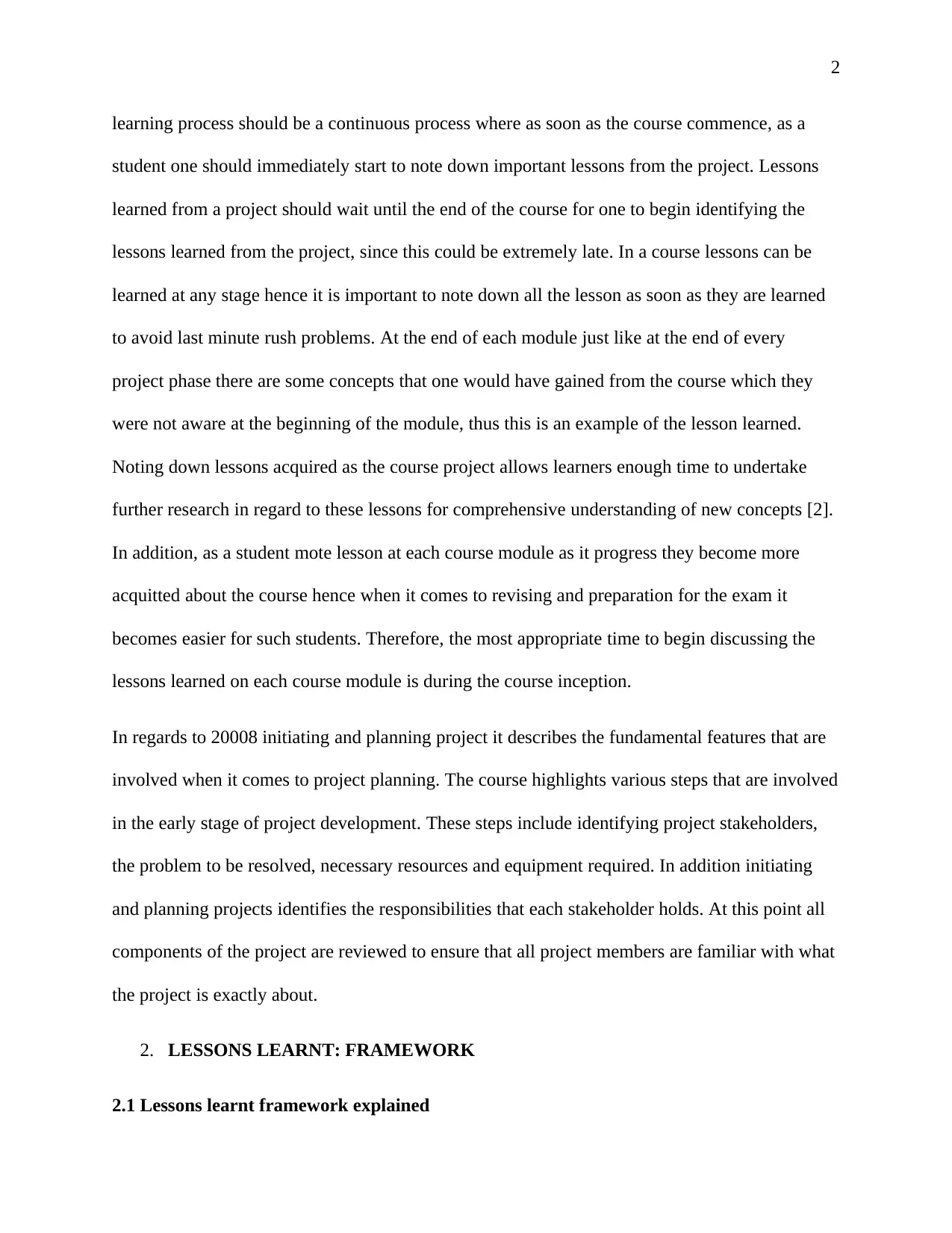
2
learning process should be a continuous process where as soon as the course commence, as a
student one should immediately start to note down important lessons from the project. Lessons
learned from a project should wait until the end of the course for one to begin identifying the
lessons learned from the project, since this could be extremely late. In a course lessons can be
learned at any stage hence it is important to note down all the lesson as soon as they are learned
to avoid last minute rush problems. At the end of each module just like at the end of every
project phase there are some concepts that one would have gained from the course which they
were not aware at the beginning of the module, thus this is an example of the lesson learned.
Noting down lessons acquired as the course project allows learners enough time to undertake
further research in regard to these lessons for comprehensive understanding of new concepts [2].
In addition, as a student mote lesson at each course module as it progress they become more
acquitted about the course hence when it comes to revising and preparation for the exam it
becomes easier for such students. Therefore, the most appropriate time to begin discussing the
lessons learned on each course module is during the course inception.
In regards to 20008 initiating and planning project it describes the fundamental features that are
involved when it comes to project planning. The course highlights various steps that are involved
in the early stage of project development. These steps include identifying project stakeholders,
the problem to be resolved, necessary resources and equipment required. In addition initiating
and planning projects identifies the responsibilities that each stakeholder holds. At this point all
components of the project are reviewed to ensure that all project members are familiar with what
the project is exactly about.
2. LESSONS LEARNT: FRAMEWORK
2.1 Lessons learnt framework explained
learning process should be a continuous process where as soon as the course commence, as a
student one should immediately start to note down important lessons from the project. Lessons
learned from a project should wait until the end of the course for one to begin identifying the
lessons learned from the project, since this could be extremely late. In a course lessons can be
learned at any stage hence it is important to note down all the lesson as soon as they are learned
to avoid last minute rush problems. At the end of each module just like at the end of every
project phase there are some concepts that one would have gained from the course which they
were not aware at the beginning of the module, thus this is an example of the lesson learned.
Noting down lessons acquired as the course project allows learners enough time to undertake
further research in regard to these lessons for comprehensive understanding of new concepts [2].
In addition, as a student mote lesson at each course module as it progress they become more
acquitted about the course hence when it comes to revising and preparation for the exam it
becomes easier for such students. Therefore, the most appropriate time to begin discussing the
lessons learned on each course module is during the course inception.
In regards to 20008 initiating and planning project it describes the fundamental features that are
involved when it comes to project planning. The course highlights various steps that are involved
in the early stage of project development. These steps include identifying project stakeholders,
the problem to be resolved, necessary resources and equipment required. In addition initiating
and planning projects identifies the responsibilities that each stakeholder holds. At this point all
components of the project are reviewed to ensure that all project members are familiar with what
the project is exactly about.
2. LESSONS LEARNT: FRAMEWORK
2.1 Lessons learnt framework explained
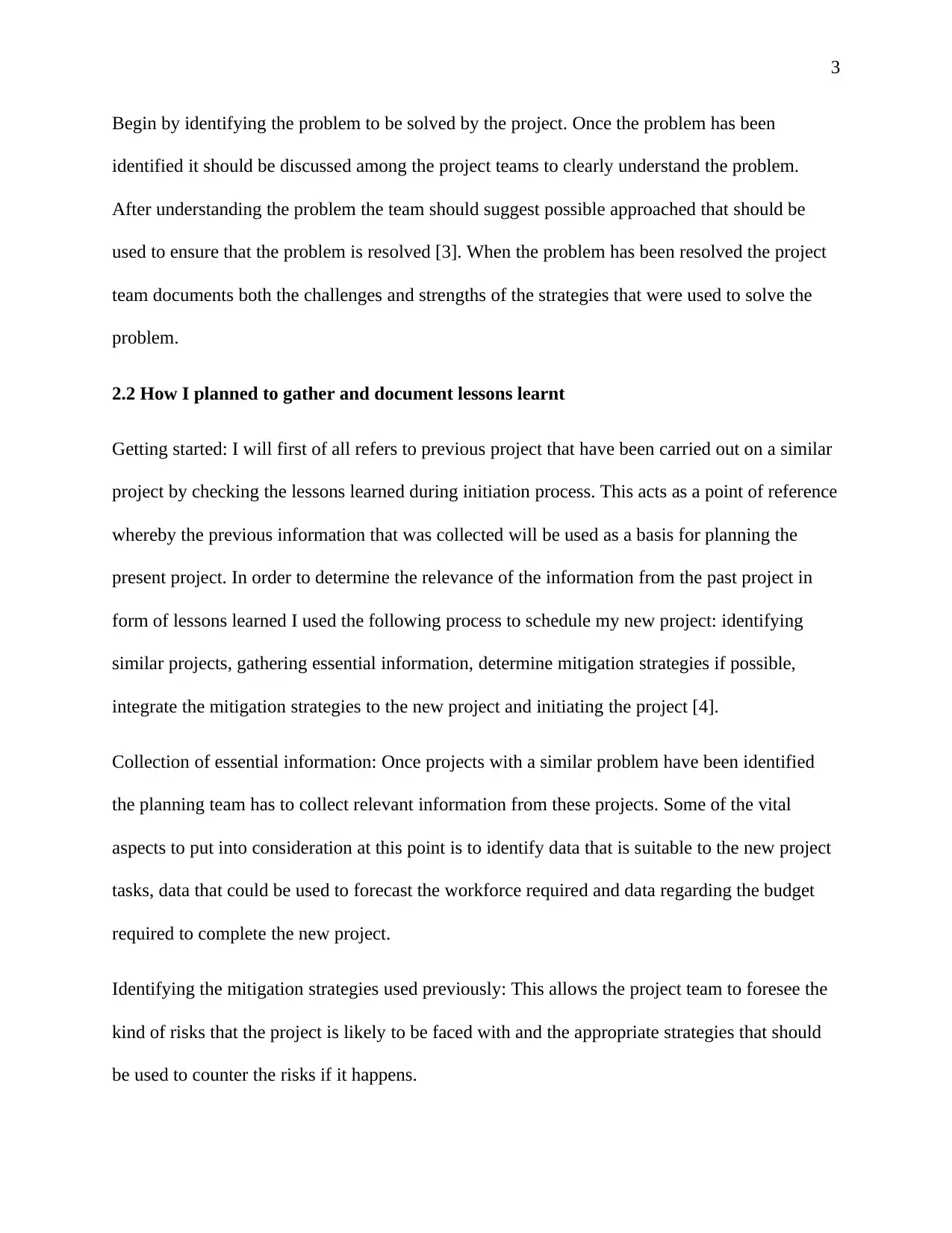
3
Begin by identifying the problem to be solved by the project. Once the problem has been
identified it should be discussed among the project teams to clearly understand the problem.
After understanding the problem the team should suggest possible approached that should be
used to ensure that the problem is resolved [3]. When the problem has been resolved the project
team documents both the challenges and strengths of the strategies that were used to solve the
problem.
2.2 How I planned to gather and document lessons learnt
Getting started: I will first of all refers to previous project that have been carried out on a similar
project by checking the lessons learned during initiation process. This acts as a point of reference
whereby the previous information that was collected will be used as a basis for planning the
present project. In order to determine the relevance of the information from the past project in
form of lessons learned I used the following process to schedule my new project: identifying
similar projects, gathering essential information, determine mitigation strategies if possible,
integrate the mitigation strategies to the new project and initiating the project [4].
Collection of essential information: Once projects with a similar problem have been identified
the planning team has to collect relevant information from these projects. Some of the vital
aspects to put into consideration at this point is to identify data that is suitable to the new project
tasks, data that could be used to forecast the workforce required and data regarding the budget
required to complete the new project.
Identifying the mitigation strategies used previously: This allows the project team to foresee the
kind of risks that the project is likely to be faced with and the appropriate strategies that should
be used to counter the risks if it happens.
Begin by identifying the problem to be solved by the project. Once the problem has been
identified it should be discussed among the project teams to clearly understand the problem.
After understanding the problem the team should suggest possible approached that should be
used to ensure that the problem is resolved [3]. When the problem has been resolved the project
team documents both the challenges and strengths of the strategies that were used to solve the
problem.
2.2 How I planned to gather and document lessons learnt
Getting started: I will first of all refers to previous project that have been carried out on a similar
project by checking the lessons learned during initiation process. This acts as a point of reference
whereby the previous information that was collected will be used as a basis for planning the
present project. In order to determine the relevance of the information from the past project in
form of lessons learned I used the following process to schedule my new project: identifying
similar projects, gathering essential information, determine mitigation strategies if possible,
integrate the mitigation strategies to the new project and initiating the project [4].
Collection of essential information: Once projects with a similar problem have been identified
the planning team has to collect relevant information from these projects. Some of the vital
aspects to put into consideration at this point is to identify data that is suitable to the new project
tasks, data that could be used to forecast the workforce required and data regarding the budget
required to complete the new project.
Identifying the mitigation strategies used previously: This allows the project team to foresee the
kind of risks that the project is likely to be faced with and the appropriate strategies that should
be used to counter the risks if it happens.
⊘ This is a preview!⊘
Do you want full access?
Subscribe today to unlock all pages.

Trusted by 1+ million students worldwide
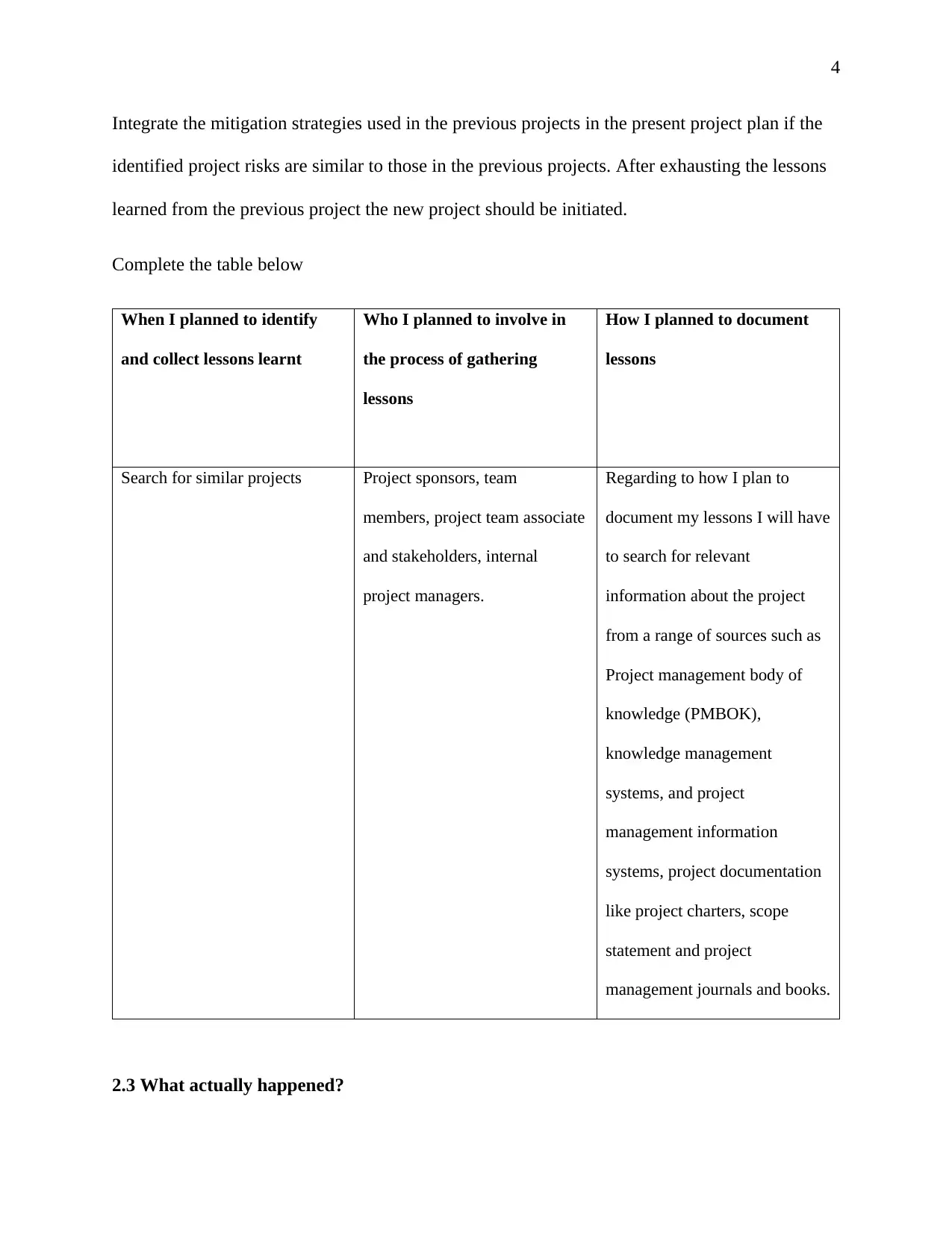
4
Integrate the mitigation strategies used in the previous projects in the present project plan if the
identified project risks are similar to those in the previous projects. After exhausting the lessons
learned from the previous project the new project should be initiated.
Complete the table below
When I planned to identify
and collect lessons learnt
Who I planned to involve in
the process of gathering
lessons
How I planned to document
lessons
Search for similar projects Project sponsors, team
members, project team associate
and stakeholders, internal
project managers.
Regarding to how I plan to
document my lessons I will have
to search for relevant
information about the project
from a range of sources such as
Project management body of
knowledge (PMBOK),
knowledge management
systems, and project
management information
systems, project documentation
like project charters, scope
statement and project
management journals and books.
2.3 What actually happened?
Integrate the mitigation strategies used in the previous projects in the present project plan if the
identified project risks are similar to those in the previous projects. After exhausting the lessons
learned from the previous project the new project should be initiated.
Complete the table below
When I planned to identify
and collect lessons learnt
Who I planned to involve in
the process of gathering
lessons
How I planned to document
lessons
Search for similar projects Project sponsors, team
members, project team associate
and stakeholders, internal
project managers.
Regarding to how I plan to
document my lessons I will have
to search for relevant
information about the project
from a range of sources such as
Project management body of
knowledge (PMBOK),
knowledge management
systems, and project
management information
systems, project documentation
like project charters, scope
statement and project
management journals and books.
2.3 What actually happened?
Paraphrase This Document
Need a fresh take? Get an instant paraphrase of this document with our AI Paraphraser
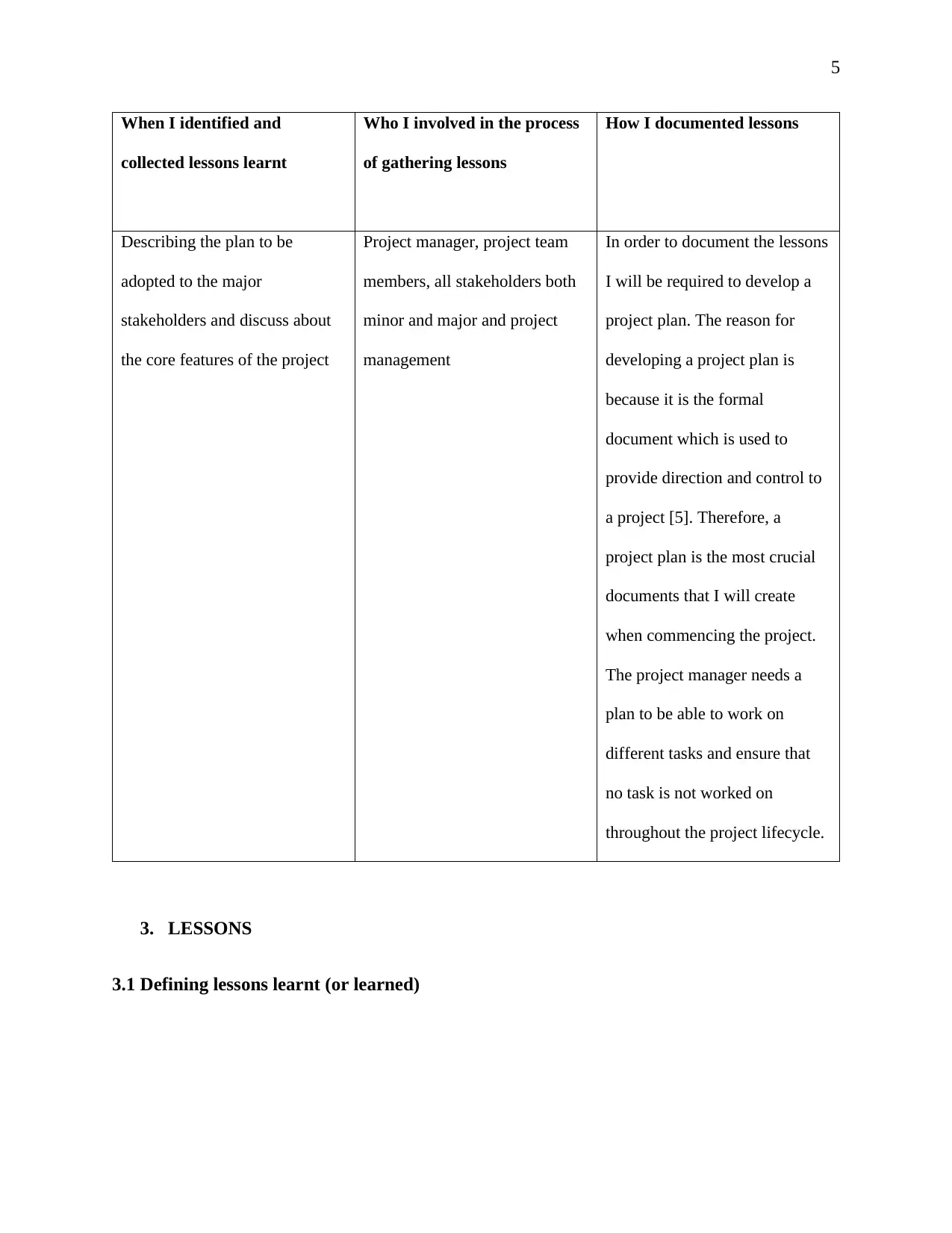
5
When I identified and
collected lessons learnt
Who I involved in the process
of gathering lessons
How I documented lessons
Describing the plan to be
adopted to the major
stakeholders and discuss about
the core features of the project
Project manager, project team
members, all stakeholders both
minor and major and project
management
In order to document the lessons
I will be required to develop a
project plan. The reason for
developing a project plan is
because it is the formal
document which is used to
provide direction and control to
a project [5]. Therefore, a
project plan is the most crucial
documents that I will create
when commencing the project.
The project manager needs a
plan to be able to work on
different tasks and ensure that
no task is not worked on
throughout the project lifecycle.
3. LESSONS
3.1 Defining lessons learnt (or learned)
When I identified and
collected lessons learnt
Who I involved in the process
of gathering lessons
How I documented lessons
Describing the plan to be
adopted to the major
stakeholders and discuss about
the core features of the project
Project manager, project team
members, all stakeholders both
minor and major and project
management
In order to document the lessons
I will be required to develop a
project plan. The reason for
developing a project plan is
because it is the formal
document which is used to
provide direction and control to
a project [5]. Therefore, a
project plan is the most crucial
documents that I will create
when commencing the project.
The project manager needs a
plan to be able to work on
different tasks and ensure that
no task is not worked on
throughout the project lifecycle.
3. LESSONS
3.1 Defining lessons learnt (or learned)
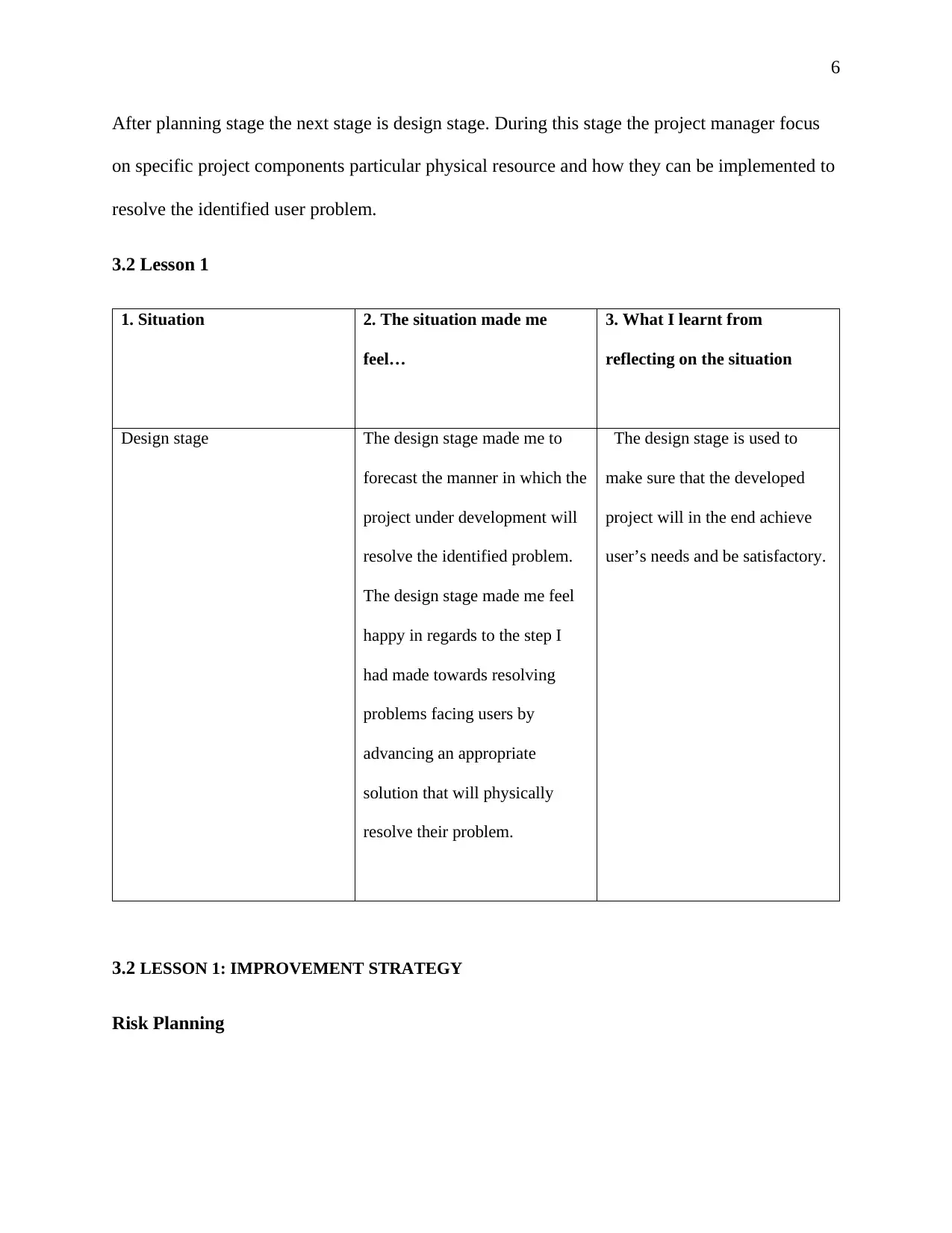
6
After planning stage the next stage is design stage. During this stage the project manager focus
on specific project components particular physical resource and how they can be implemented to
resolve the identified user problem.
3.2 Lesson 1
1. Situation 2. The situation made me
feel…
3. What I learnt from
reflecting on the situation
Design stage The design stage made me to
forecast the manner in which the
project under development will
resolve the identified problem.
The design stage made me feel
happy in regards to the step I
had made towards resolving
problems facing users by
advancing an appropriate
solution that will physically
resolve their problem.
The design stage is used to
make sure that the developed
project will in the end achieve
user’s needs and be satisfactory.
3.2 LESSON 1: IMPROVEMENT STRATEGY
Risk Planning
After planning stage the next stage is design stage. During this stage the project manager focus
on specific project components particular physical resource and how they can be implemented to
resolve the identified user problem.
3.2 Lesson 1
1. Situation 2. The situation made me
feel…
3. What I learnt from
reflecting on the situation
Design stage The design stage made me to
forecast the manner in which the
project under development will
resolve the identified problem.
The design stage made me feel
happy in regards to the step I
had made towards resolving
problems facing users by
advancing an appropriate
solution that will physically
resolve their problem.
The design stage is used to
make sure that the developed
project will in the end achieve
user’s needs and be satisfactory.
3.2 LESSON 1: IMPROVEMENT STRATEGY
Risk Planning
⊘ This is a preview!⊘
Do you want full access?
Subscribe today to unlock all pages.

Trusted by 1+ million students worldwide
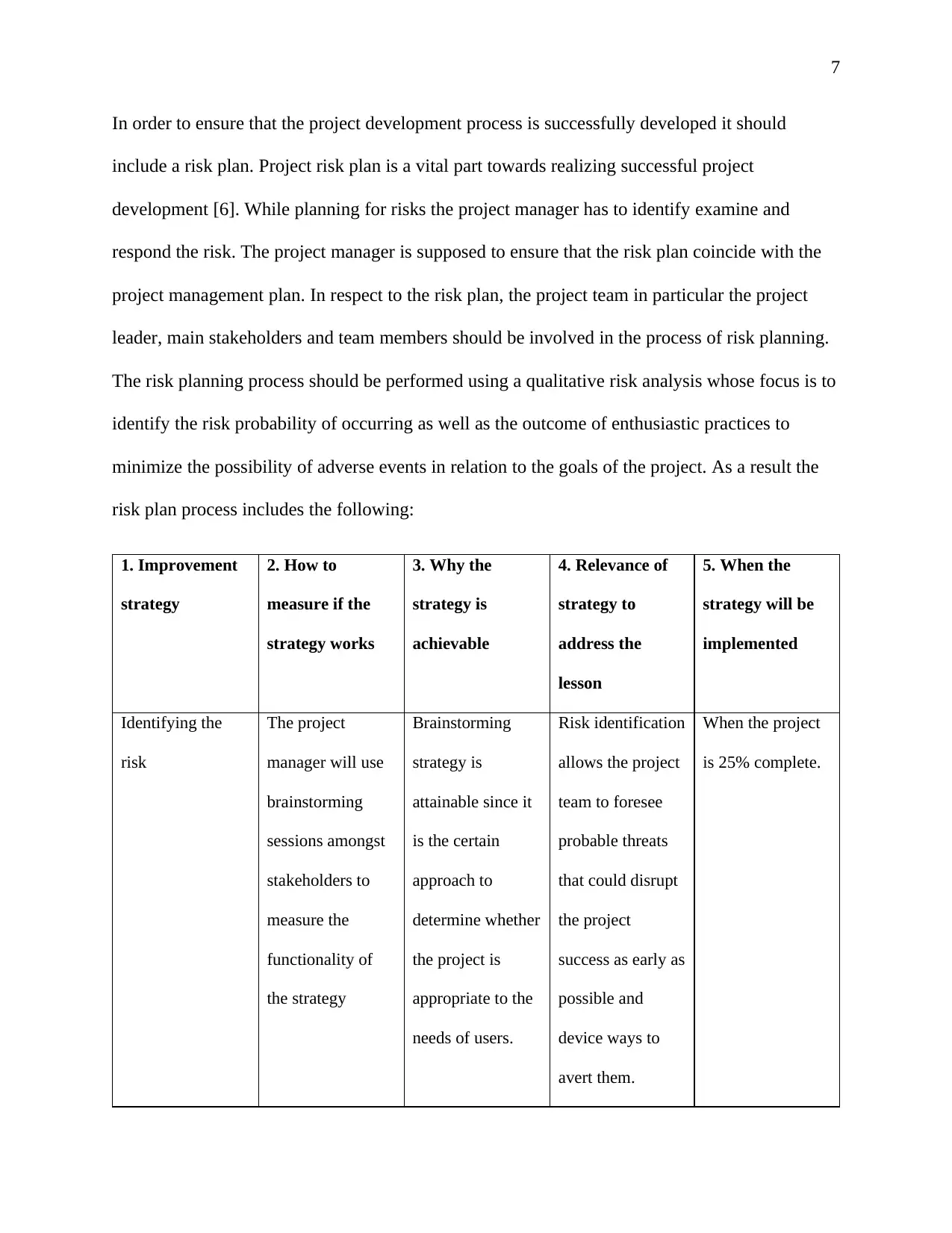
7
In order to ensure that the project development process is successfully developed it should
include a risk plan. Project risk plan is a vital part towards realizing successful project
development [6]. While planning for risks the project manager has to identify examine and
respond the risk. The project manager is supposed to ensure that the risk plan coincide with the
project management plan. In respect to the risk plan, the project team in particular the project
leader, main stakeholders and team members should be involved in the process of risk planning.
The risk planning process should be performed using a qualitative risk analysis whose focus is to
identify the risk probability of occurring as well as the outcome of enthusiastic practices to
minimize the possibility of adverse events in relation to the goals of the project. As a result the
risk plan process includes the following:
1. Improvement
strategy
2. How to
measure if the
strategy works
3. Why the
strategy is
achievable
4. Relevance of
strategy to
address the
lesson
5. When the
strategy will be
implemented
Identifying the
risk
The project
manager will use
brainstorming
sessions amongst
stakeholders to
measure the
functionality of
the strategy
Brainstorming
strategy is
attainable since it
is the certain
approach to
determine whether
the project is
appropriate to the
needs of users.
Risk identification
allows the project
team to foresee
probable threats
that could disrupt
the project
success as early as
possible and
device ways to
avert them.
When the project
is 25% complete.
In order to ensure that the project development process is successfully developed it should
include a risk plan. Project risk plan is a vital part towards realizing successful project
development [6]. While planning for risks the project manager has to identify examine and
respond the risk. The project manager is supposed to ensure that the risk plan coincide with the
project management plan. In respect to the risk plan, the project team in particular the project
leader, main stakeholders and team members should be involved in the process of risk planning.
The risk planning process should be performed using a qualitative risk analysis whose focus is to
identify the risk probability of occurring as well as the outcome of enthusiastic practices to
minimize the possibility of adverse events in relation to the goals of the project. As a result the
risk plan process includes the following:
1. Improvement
strategy
2. How to
measure if the
strategy works
3. Why the
strategy is
achievable
4. Relevance of
strategy to
address the
lesson
5. When the
strategy will be
implemented
Identifying the
risk
The project
manager will use
brainstorming
sessions amongst
stakeholders to
measure the
functionality of
the strategy
Brainstorming
strategy is
attainable since it
is the certain
approach to
determine whether
the project is
appropriate to the
needs of users.
Risk identification
allows the project
team to foresee
probable threats
that could disrupt
the project
success as early as
possible and
device ways to
avert them.
When the project
is 25% complete.
Paraphrase This Document
Need a fresh take? Get an instant paraphrase of this document with our AI Paraphraser
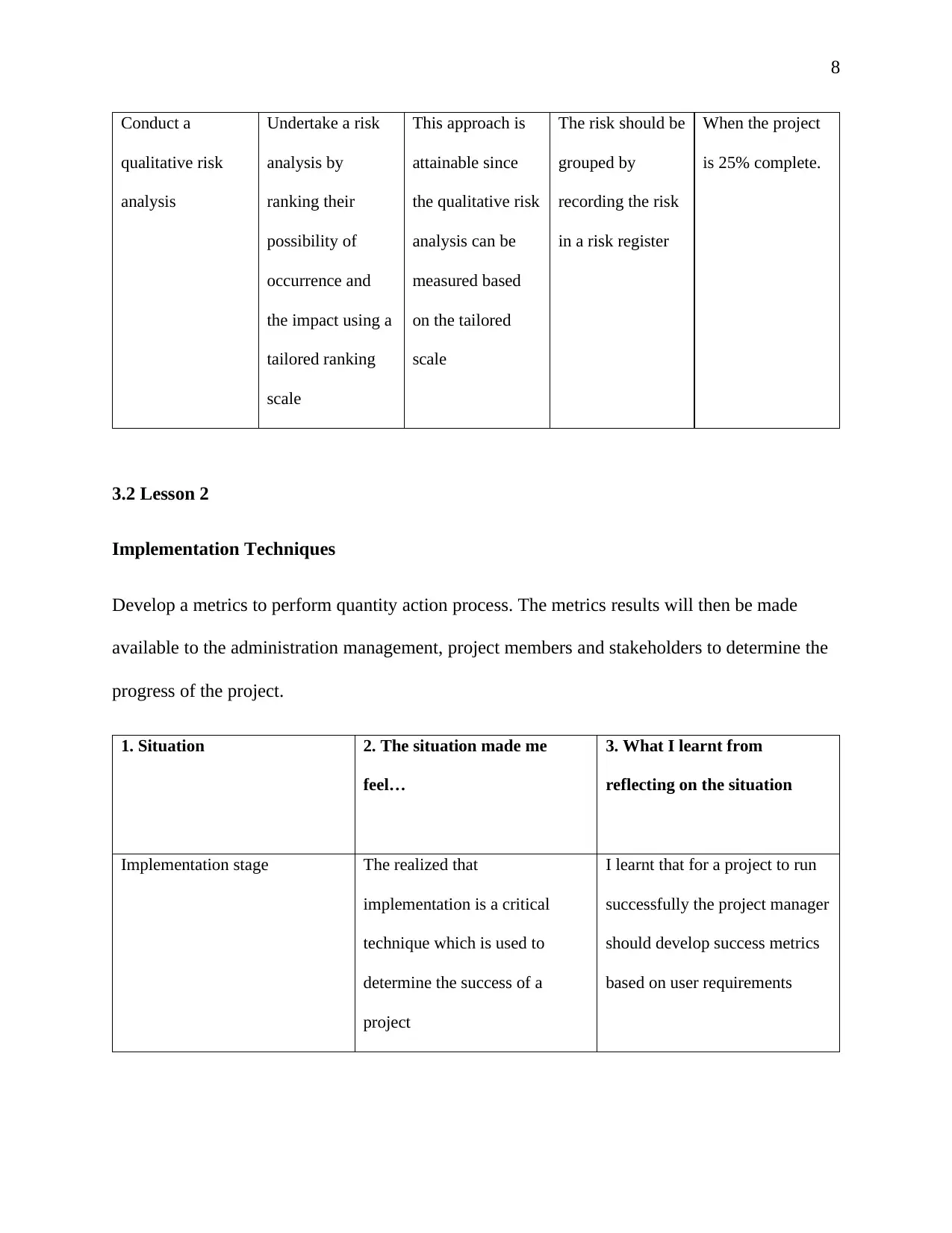
8
Conduct a
qualitative risk
analysis
Undertake a risk
analysis by
ranking their
possibility of
occurrence and
the impact using a
tailored ranking
scale
This approach is
attainable since
the qualitative risk
analysis can be
measured based
on the tailored
scale
The risk should be
grouped by
recording the risk
in a risk register
When the project
is 25% complete.
3.2 Lesson 2
Implementation Techniques
Develop a metrics to perform quantity action process. The metrics results will then be made
available to the administration management, project members and stakeholders to determine the
progress of the project.
1. Situation 2. The situation made me
feel…
3. What I learnt from
reflecting on the situation
Implementation stage The realized that
implementation is a critical
technique which is used to
determine the success of a
project
I learnt that for a project to run
successfully the project manager
should develop success metrics
based on user requirements
Conduct a
qualitative risk
analysis
Undertake a risk
analysis by
ranking their
possibility of
occurrence and
the impact using a
tailored ranking
scale
This approach is
attainable since
the qualitative risk
analysis can be
measured based
on the tailored
scale
The risk should be
grouped by
recording the risk
in a risk register
When the project
is 25% complete.
3.2 Lesson 2
Implementation Techniques
Develop a metrics to perform quantity action process. The metrics results will then be made
available to the administration management, project members and stakeholders to determine the
progress of the project.
1. Situation 2. The situation made me
feel…
3. What I learnt from
reflecting on the situation
Implementation stage The realized that
implementation is a critical
technique which is used to
determine the success of a
project
I learnt that for a project to run
successfully the project manager
should develop success metrics
based on user requirements
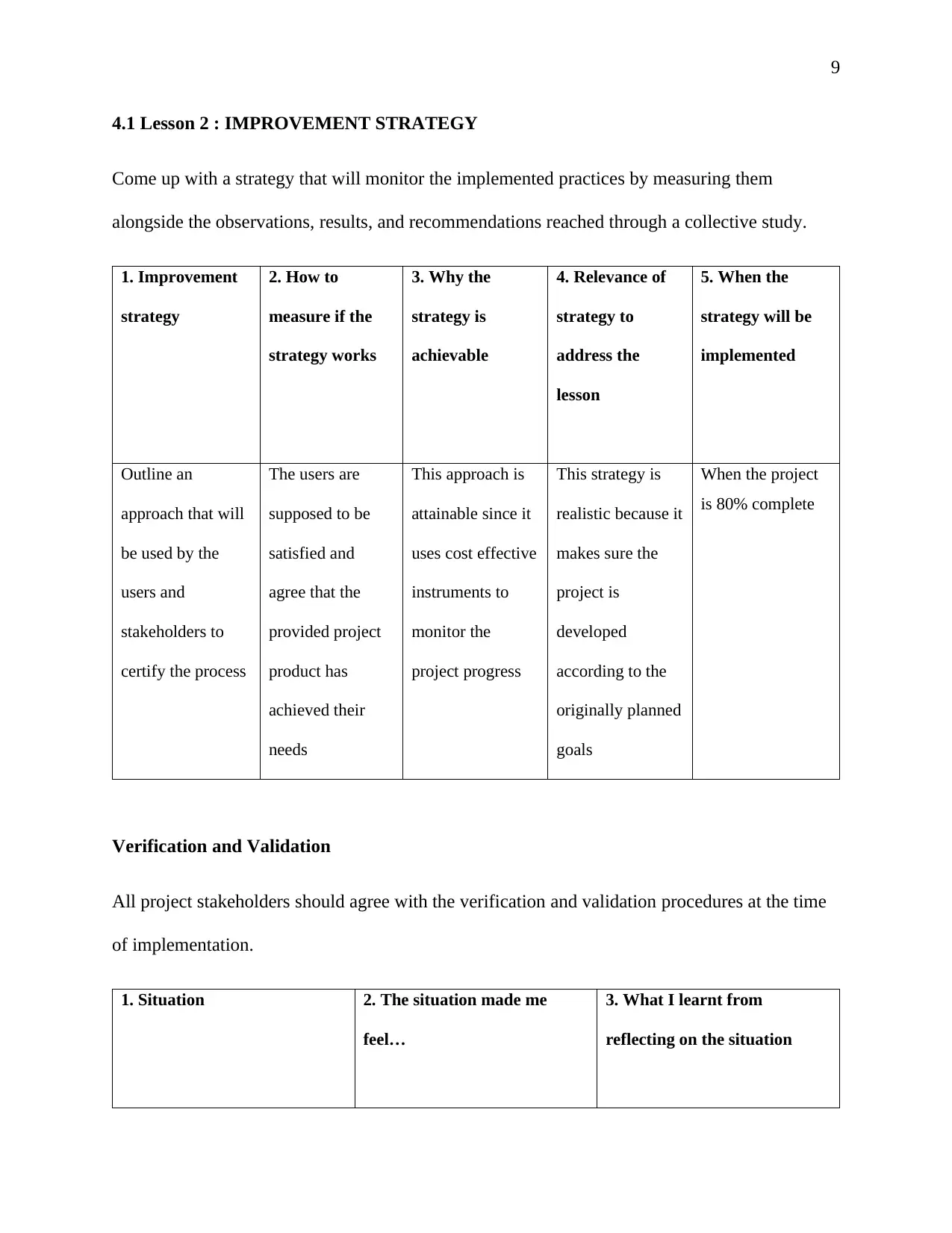
9
4.1 Lesson 2 : IMPROVEMENT STRATEGY
Come up with a strategy that will monitor the implemented practices by measuring them
alongside the observations, results, and recommendations reached through a collective study.
1. Improvement
strategy
2. How to
measure if the
strategy works
3. Why the
strategy is
achievable
4. Relevance of
strategy to
address the
lesson
5. When the
strategy will be
implemented
Outline an
approach that will
be used by the
users and
stakeholders to
certify the process
The users are
supposed to be
satisfied and
agree that the
provided project
product has
achieved their
needs
This approach is
attainable since it
uses cost effective
instruments to
monitor the
project progress
This strategy is
realistic because it
makes sure the
project is
developed
according to the
originally planned
goals
When the project
is 80% complete
Verification and Validation
All project stakeholders should agree with the verification and validation procedures at the time
of implementation.
1. Situation 2. The situation made me
feel…
3. What I learnt from
reflecting on the situation
4.1 Lesson 2 : IMPROVEMENT STRATEGY
Come up with a strategy that will monitor the implemented practices by measuring them
alongside the observations, results, and recommendations reached through a collective study.
1. Improvement
strategy
2. How to
measure if the
strategy works
3. Why the
strategy is
achievable
4. Relevance of
strategy to
address the
lesson
5. When the
strategy will be
implemented
Outline an
approach that will
be used by the
users and
stakeholders to
certify the process
The users are
supposed to be
satisfied and
agree that the
provided project
product has
achieved their
needs
This approach is
attainable since it
uses cost effective
instruments to
monitor the
project progress
This strategy is
realistic because it
makes sure the
project is
developed
according to the
originally planned
goals
When the project
is 80% complete
Verification and Validation
All project stakeholders should agree with the verification and validation procedures at the time
of implementation.
1. Situation 2. The situation made me
feel…
3. What I learnt from
reflecting on the situation
⊘ This is a preview!⊘
Do you want full access?
Subscribe today to unlock all pages.

Trusted by 1+ million students worldwide
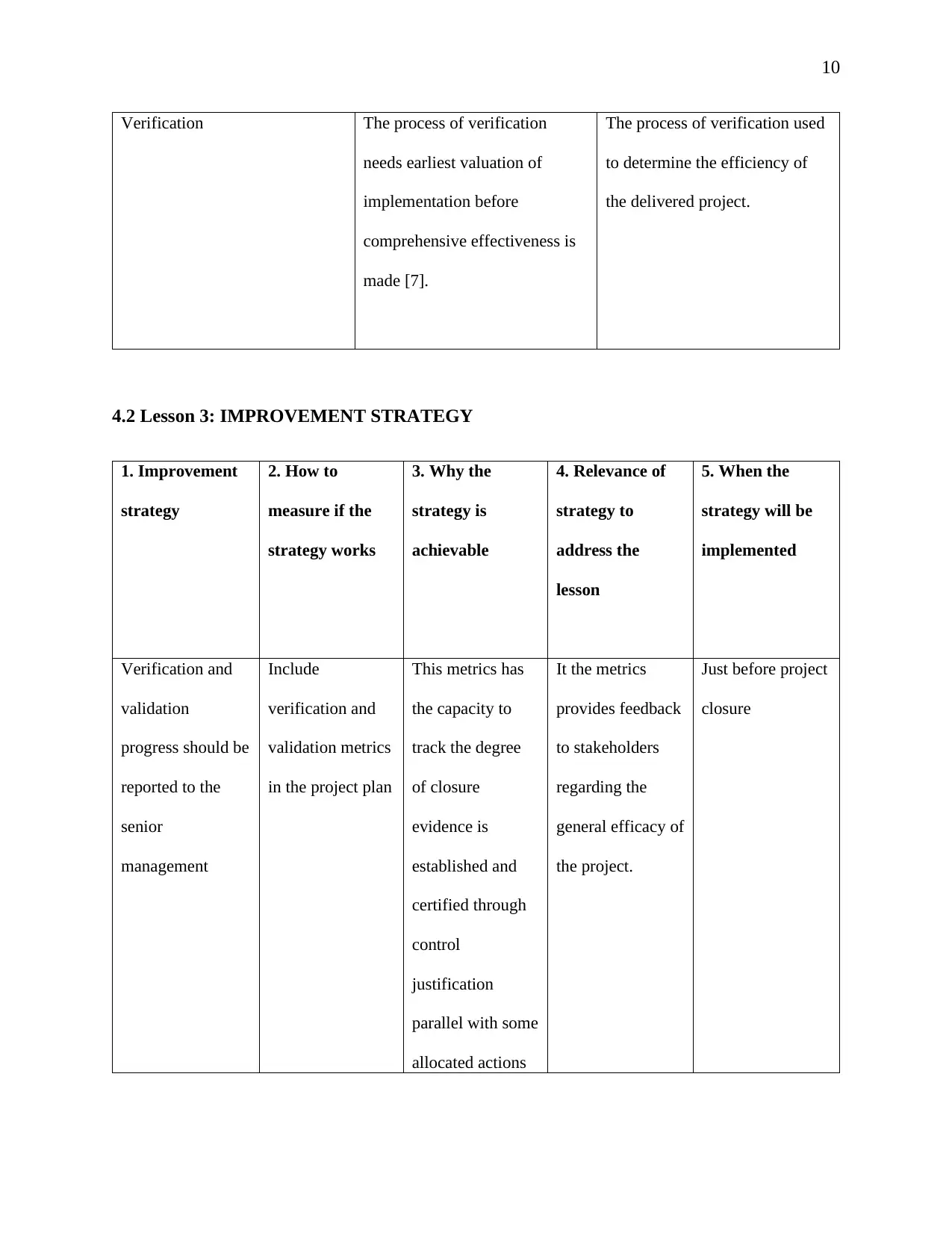
10
Verification The process of verification
needs earliest valuation of
implementation before
comprehensive effectiveness is
made [7].
The process of verification used
to determine the efficiency of
the delivered project.
4.2 Lesson 3: IMPROVEMENT STRATEGY
1. Improvement
strategy
2. How to
measure if the
strategy works
3. Why the
strategy is
achievable
4. Relevance of
strategy to
address the
lesson
5. When the
strategy will be
implemented
Verification and
validation
progress should be
reported to the
senior
management
Include
verification and
validation metrics
in the project plan
This metrics has
the capacity to
track the degree
of closure
evidence is
established and
certified through
control
justification
parallel with some
allocated actions
It the metrics
provides feedback
to stakeholders
regarding the
general efficacy of
the project.
Just before project
closure
Verification The process of verification
needs earliest valuation of
implementation before
comprehensive effectiveness is
made [7].
The process of verification used
to determine the efficiency of
the delivered project.
4.2 Lesson 3: IMPROVEMENT STRATEGY
1. Improvement
strategy
2. How to
measure if the
strategy works
3. Why the
strategy is
achievable
4. Relevance of
strategy to
address the
lesson
5. When the
strategy will be
implemented
Verification and
validation
progress should be
reported to the
senior
management
Include
verification and
validation metrics
in the project plan
This metrics has
the capacity to
track the degree
of closure
evidence is
established and
certified through
control
justification
parallel with some
allocated actions
It the metrics
provides feedback
to stakeholders
regarding the
general efficacy of
the project.
Just before project
closure
Paraphrase This Document
Need a fresh take? Get an instant paraphrase of this document with our AI Paraphraser
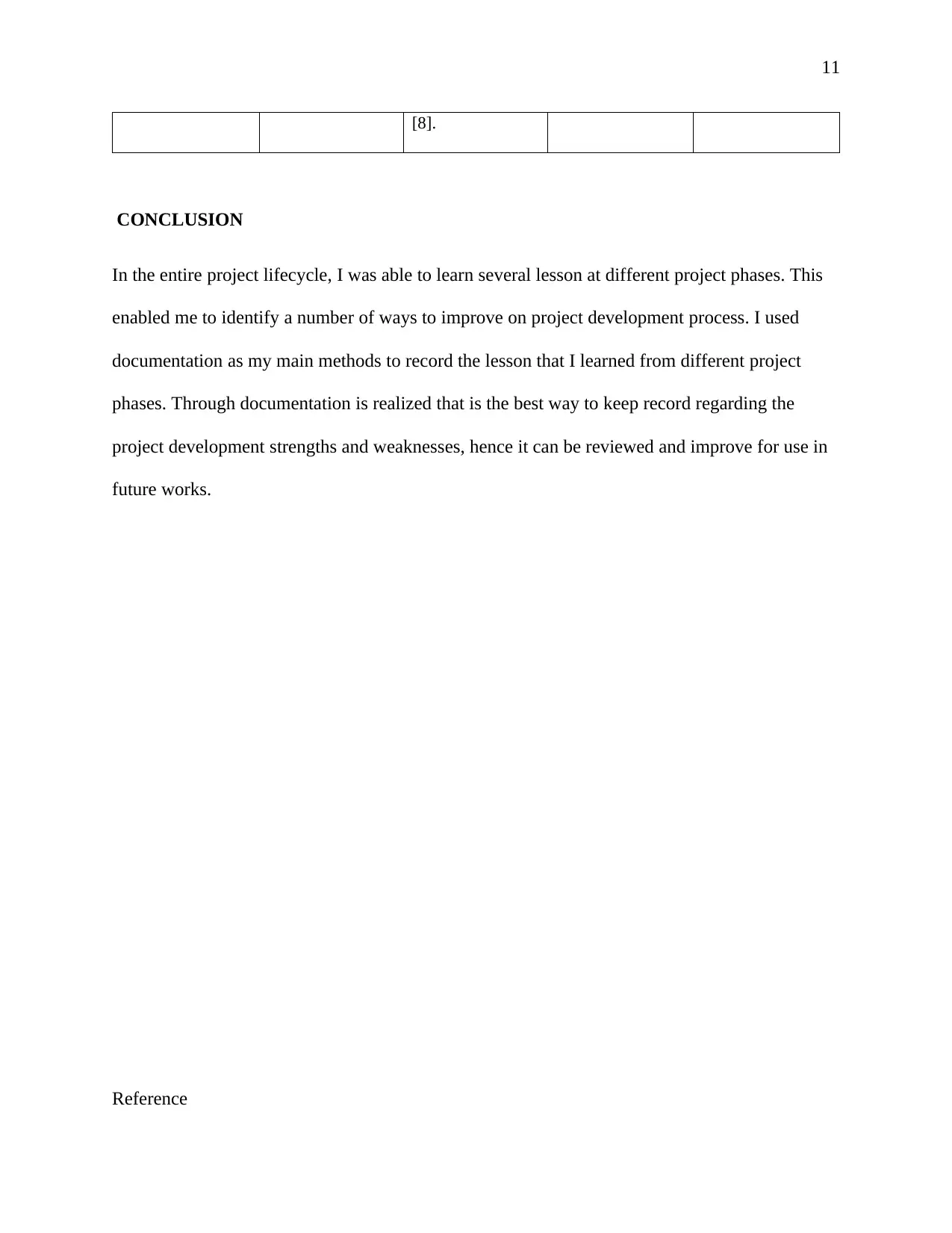
11
[8].
CONCLUSION
In the entire project lifecycle, I was able to learn several lesson at different project phases. This
enabled me to identify a number of ways to improve on project development process. I used
documentation as my main methods to record the lesson that I learned from different project
phases. Through documentation is realized that is the best way to keep record regarding the
project development strengths and weaknesses, hence it can be reviewed and improve for use in
future works.
Reference
[8].
CONCLUSION
In the entire project lifecycle, I was able to learn several lesson at different project phases. This
enabled me to identify a number of ways to improve on project development process. I used
documentation as my main methods to record the lesson that I learned from different project
phases. Through documentation is realized that is the best way to keep record regarding the
project development strengths and weaknesses, hence it can be reviewed and improve for use in
future works.
Reference
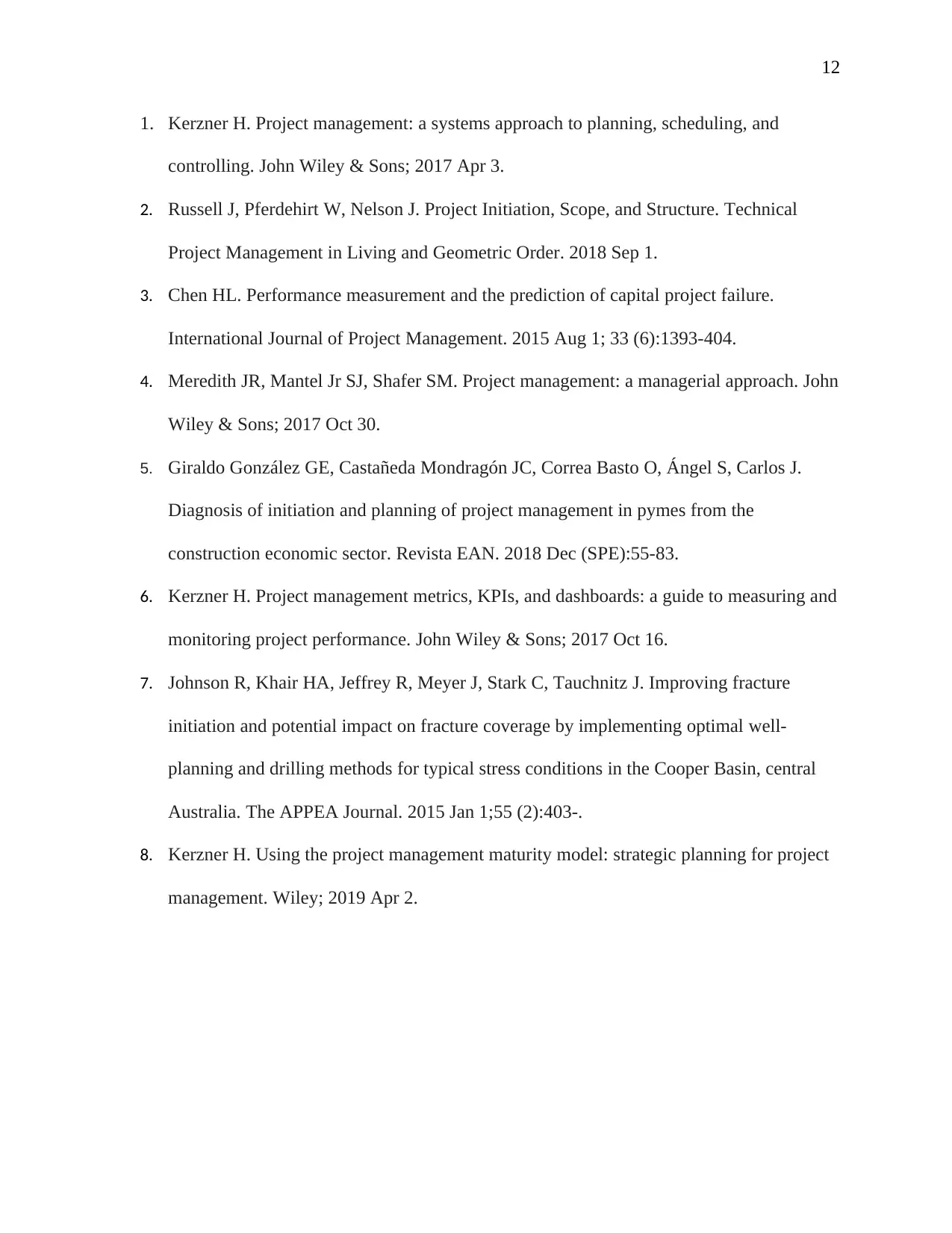
12
1. Kerzner H. Project management: a systems approach to planning, scheduling, and
controlling. John Wiley & Sons; 2017 Apr 3.
2. Russell J, Pferdehirt W, Nelson J. Project Initiation, Scope, and Structure. Technical
Project Management in Living and Geometric Order. 2018 Sep 1.
3. Chen HL. Performance measurement and the prediction of capital project failure.
International Journal of Project Management. 2015 Aug 1; 33 (6):1393-404.
4. Meredith JR, Mantel Jr SJ, Shafer SM. Project management: a managerial approach. John
Wiley & Sons; 2017 Oct 30.
5. Giraldo González GE, Castañeda Mondragón JC, Correa Basto O, Ángel S, Carlos J.
Diagnosis of initiation and planning of project management in pymes from the
construction economic sector. Revista EAN. 2018 Dec (SPE):55-83.
6. Kerzner H. Project management metrics, KPIs, and dashboards: a guide to measuring and
monitoring project performance. John Wiley & Sons; 2017 Oct 16.
7. Johnson R, Khair HA, Jeffrey R, Meyer J, Stark C, Tauchnitz J. Improving fracture
initiation and potential impact on fracture coverage by implementing optimal well-
planning and drilling methods for typical stress conditions in the Cooper Basin, central
Australia. The APPEA Journal. 2015 Jan 1;55 (2):403-.
8. Kerzner H. Using the project management maturity model: strategic planning for project
management. Wiley; 2019 Apr 2.
1. Kerzner H. Project management: a systems approach to planning, scheduling, and
controlling. John Wiley & Sons; 2017 Apr 3.
2. Russell J, Pferdehirt W, Nelson J. Project Initiation, Scope, and Structure. Technical
Project Management in Living and Geometric Order. 2018 Sep 1.
3. Chen HL. Performance measurement and the prediction of capital project failure.
International Journal of Project Management. 2015 Aug 1; 33 (6):1393-404.
4. Meredith JR, Mantel Jr SJ, Shafer SM. Project management: a managerial approach. John
Wiley & Sons; 2017 Oct 30.
5. Giraldo González GE, Castañeda Mondragón JC, Correa Basto O, Ángel S, Carlos J.
Diagnosis of initiation and planning of project management in pymes from the
construction economic sector. Revista EAN. 2018 Dec (SPE):55-83.
6. Kerzner H. Project management metrics, KPIs, and dashboards: a guide to measuring and
monitoring project performance. John Wiley & Sons; 2017 Oct 16.
7. Johnson R, Khair HA, Jeffrey R, Meyer J, Stark C, Tauchnitz J. Improving fracture
initiation and potential impact on fracture coverage by implementing optimal well-
planning and drilling methods for typical stress conditions in the Cooper Basin, central
Australia. The APPEA Journal. 2015 Jan 1;55 (2):403-.
8. Kerzner H. Using the project management maturity model: strategic planning for project
management. Wiley; 2019 Apr 2.
⊘ This is a preview!⊘
Do you want full access?
Subscribe today to unlock all pages.

Trusted by 1+ million students worldwide
1 out of 12
Related Documents
Your All-in-One AI-Powered Toolkit for Academic Success.
+13062052269
info@desklib.com
Available 24*7 on WhatsApp / Email
![[object Object]](/_next/static/media/star-bottom.7253800d.svg)
Unlock your academic potential
Copyright © 2020–2025 A2Z Services. All Rights Reserved. Developed and managed by ZUCOL.




